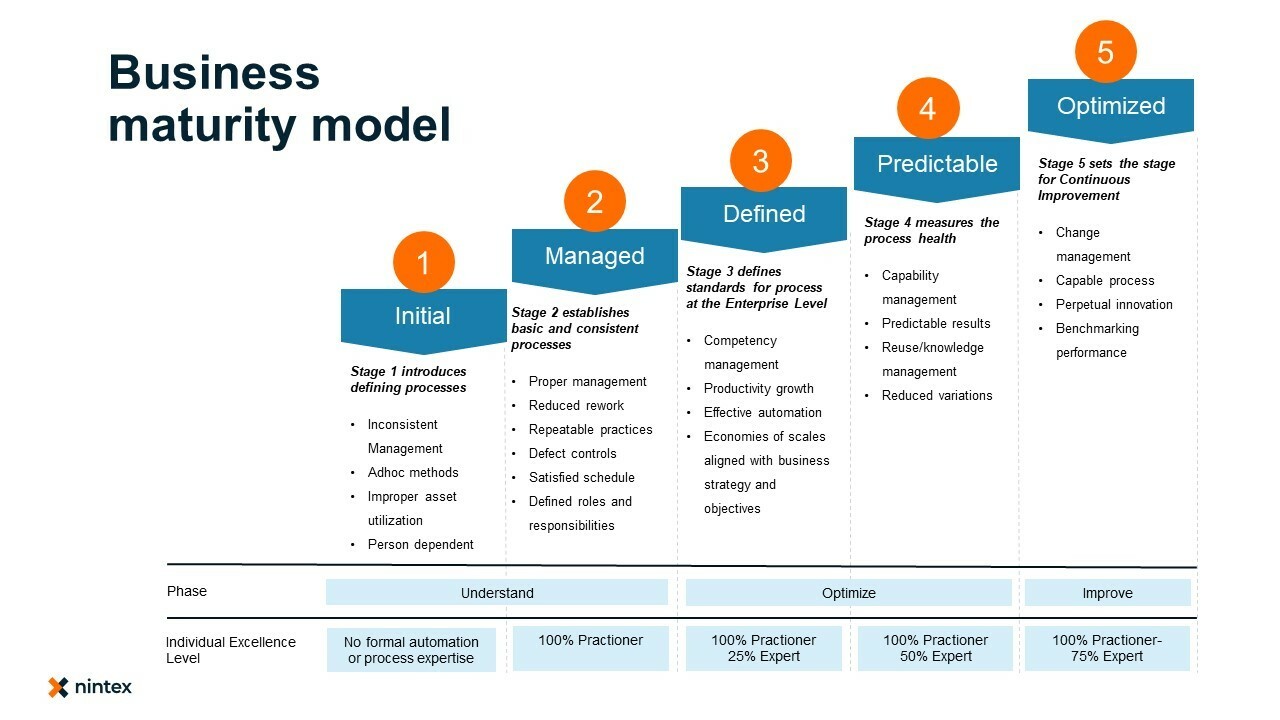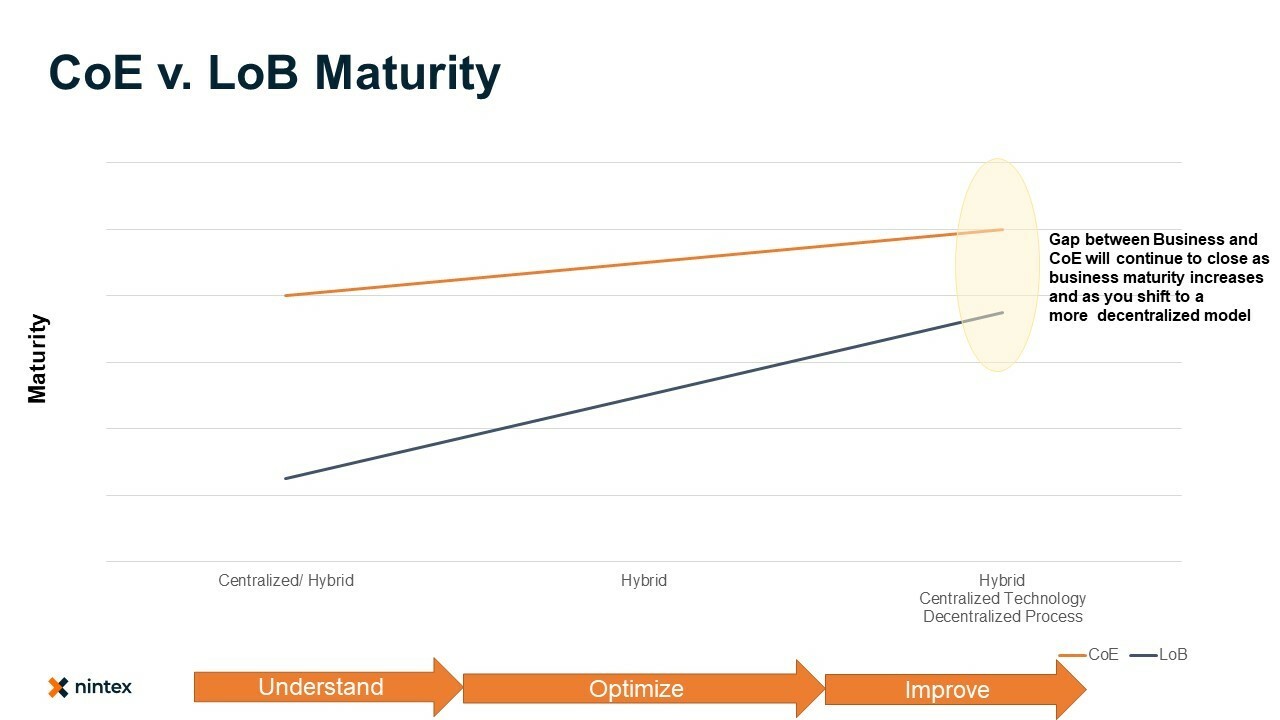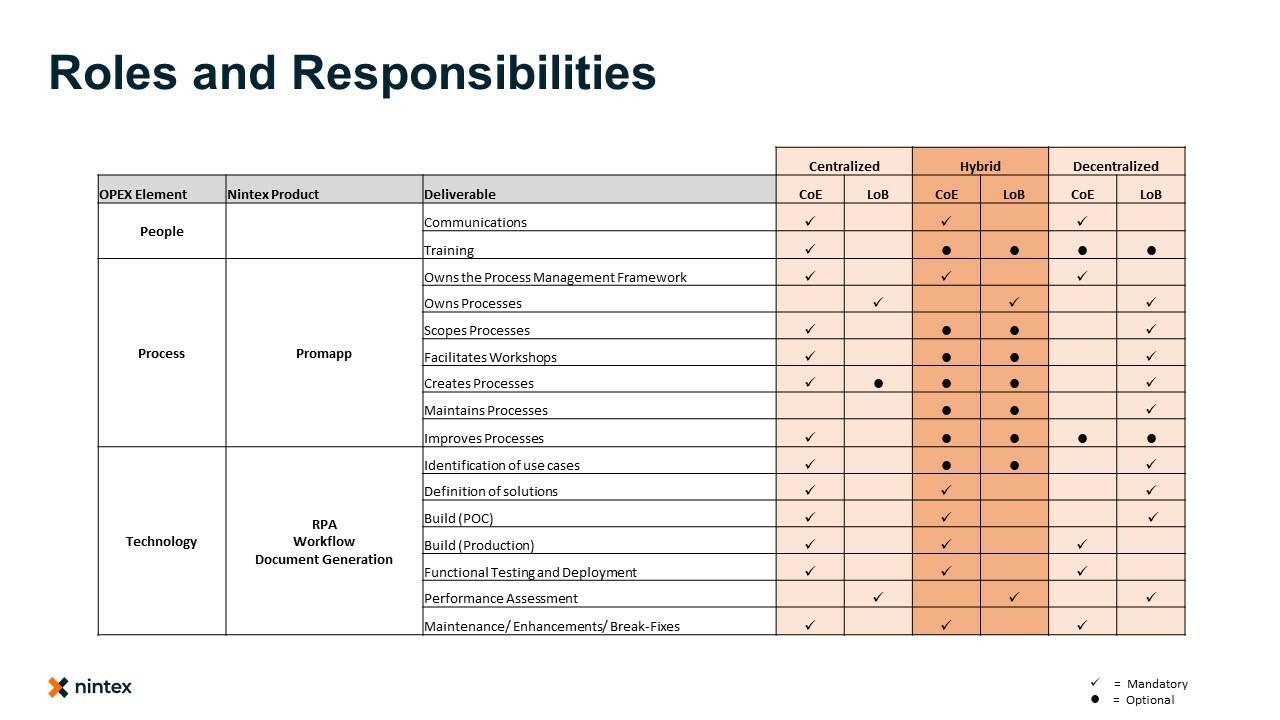What is business maturity and how does it influence your CoE?
To summarize what we’ve discussed so far, your CoE can take one of three approaches (Centralized, Decentralized, or Hybrid) and the approach that you select will determine how you structure and staff your CoE. So how do you know which is the best approach and structure to adopt? The simple answer is that you should align your approach with your maturity level and, as your level of maturity changes, so should your CoE.
There are literally hundreds of maturity models in the market today, some are so complex that in the end it is virtually impossible to achieve the highest stage. Most organizations will find their own level of maturity that is right for them to accomplish their desired goals. In the model presented here the intent is to move from an Initial stage, let’s say you’re still doing things manually with paper and pen, to the fully optimized stage, leveraging technology in a state of perpetual improvement.

Let’s break each stage down into phases.
Understand phase
We are determining our starting position and laying the groundwork. This is a great time to engage multiple personas, for example Line of Business and IT to go through a maturity mapping exercise together. What you’ll find is that almost everyone will identify themselves or their team at different levels of maturity. This is where a discussion of where the gaps are and how to close those gaps with assigned resources.
Optimized phase
At this phase you are focusing on building and standardizing the delivery approach, reducing rework, moving from tactical to strategic. The final goal is the optimization of the underlying process.
Improve phase
At the Improve phase the momentum is for continuous improvement. With a process foundation established you are liberated to review, revise and implement improvement changes that provide ongoing benefits.
Individual Excellence
At the bottom of the maturity model is an Individual Excellence Level. At each stage there should be an expectation that individuals are gaining an expertise in their field. To ensure this a training roadmap for skills is essential. As the individual increases their expertise you move from a “quantity” based approach to a “quality based” approach.
CoE v. LoB Maturity
It’s important to remember that as your CoE is staffed by process professionals, it will have a different level of maturity to the rest of your organization and this gap should influence what approach your CoE takes.
During the Understand Phase, where the LoB lacks maturity, the CoE will have to play a larger role, either adopting an entirely centralized approach, or a hybrid. If a hybrid approach is taken, it will likely still retain responsibility and ownership for the majority of the deliverables.

As the LoB matures, and the gap between your LoB and CoE shrinks, this responsibility can start to transition from the CoE towards the LoB. With that being said, even during the Improve phase, it is unlikely that a fully decentralized approach will be adopted, rather the CoE will continue to retain responsibilities for the technology component as well as comms and frameworks.
Roles and Responsibilities
This is a summary of how the CoE might transition its responsibilities over to the LoB over time.

When it comes to the people element of OPEX, the communications plan has got to be run by the CoE at every phase of maturity to ensure that a consistent message is being delivered. While the communication plan itself will always be managed by the CoE, members from the LoB (specifically leadership) will be required to deliver the messages itself. During the initial phase, the CoE will be responsible for delivering training to the LoB. Over time however this responsibility might be passed or shared with the LoB – for example managers could be responsible for showing new starters how to find and follow a process in Promapp, however if that new starter would like to know how to build a Bot, that training would be delivered by the CoE.
The Process element of OPEX can be resource heavy during the initial, build phase, however ongoing maintenance and improvement requires a significantly lower time commitment. As a result, the CoE will often be very hands on during the initial phase by providing resources to create the initial round of processes and ensuring that the content is of a high standard. Over time though responsibility should be handed off to the LoB to the point where the CoE is only responsible for ownership of the process management framework and potentially offering support when it comes to process improvement. At all phases, the LoB must retain ownership of their processes.
The Technology element of OPEX is generally owned by the CoE across the entire maturity lifecycle as there due to the efficiency gains that can be achieved through centralization. The LoB however may take an increasingly active role over time to help identify opportunities for automation in their own processes and perhaps build their own Proof of Concepts (PoCs) for the CoE to subsequently take into production.
We have identified a method to understand the maturity of an organization then putting in motion ways to create a path to success in three phases, understanding the initial state of maturity, then building an optimized foundation of processes excellence with the final aim of continuous improvement. With this framework in place and the combination of learning about the various delivery models you are on your way to execute on your Operational Excellence (OPEX) program and set up a CoE. You’ve got the green light from your leadership team, so the question now becomes where do you start? This is our topic for next week where we look at how to structure a CoE.

